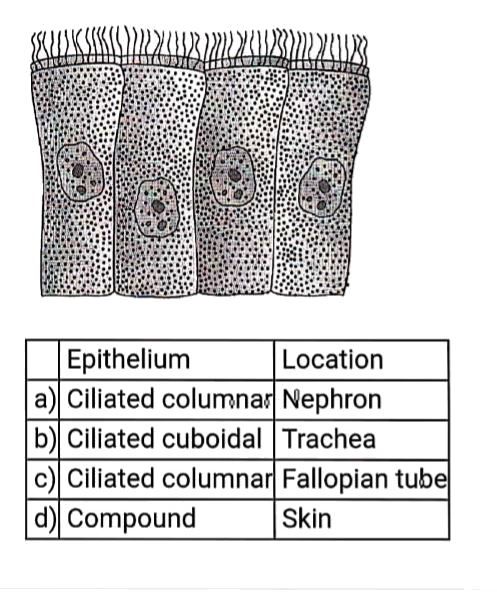Write about the special features of simple epithelium, its location, and its different types. Draw suitable diagrams alsoSolution in Tamil
(i) Simple epithelium is composed of a single layer of cells. They are found in the organs of absorption, secretion and filtration. Simple epithelial tissue is further classified into squamous epithelium, cuboidal epithelium, columnar epithelium, ciliated epithelium and pseudostratified epithelium. The squamous epithelium is made of a single thin layer of flattened cells with irregular boundaries. They are found in the kidney glomeruli, air sacs of lungs, lining of heart, blood vessels and lymphatic vessels and are involved in functions like forming a diffusion boundary and filtration in sites where protection is not important.
(ii) The cuboidal epithelium is made of a single layer of cube like cells. This tissue is commonly found in the kidney tubules, ducts and secretory portions of small glands and surface of the ovary. Its main functions are secretion and absorption.
(iii) The columnar epithelium is composed of single layer of tall cells with round to oval nuclei at the base. It lines the digestive tract from the stomach to the rectum. (iv) The functions of this epithelium include absorption, secretion of mucus, enzymes and other substances.
(v) This ciliated type propels mucus by ciliary actions and it lines the small bronchioles, fallopian tubes and uterus. Non ciliated type lines most of the digestive tract, gall bladder and secretory ducts of glands .
(vi)Pseudo-stratified epithelial cells are columnar, but unequal in size. Although the epithelium is single layered yet it appears to be multi-layered because the nuclei lie at different levels in different cells. Hence, it is also called pseudostratified epithelium and its functions are protection , secretion and absorption . Ciliated froms line the trachea and the upper respiratory track . The non ciliated froms , linr the epididymis , large ducts of a glands and tracks of male urethra.
Topper's Solved these Questions
- TISSUE LEVEL OF ORGANISATIONBOOK - PREMIERS PUBLISHERSCHAPTER - TISSUE LEVEL OF ORGANISATIONEXERCISE - SOLUTION TO TEXTUAL QUESTIONS
6 Videos
- TISSUE LEVEL OF ORGANISATIONBOOK - PREMIERS PUBLISHERSCHAPTER - TISSUE LEVEL OF ORGANISATIONEXERCISE - OTHER IMPORTANT QUESTIONS & ANSWERS (MCQ)
14 Videos
- TISSUE AND TISSUE SYSTEMBOOK - PREMIERS PUBLISHERSCHAPTER - TISSUE AND TISSUE SYSTEMEXERCISE - OTHER IMPORTANT QUESTIONS & ANSWERS (ANSWER THE FOLLOWING)
53 Videos
- TRANSPORTATION IN PLANTBOOK - PREMIERS PUBLISHERSCHAPTER - TRANSPORTATION IN PLANTEXERCISE - Solution to activity
4 Videos
Similar Questions
Straified epithelia are built for the protection or to resist abration. How are the simple epithelia better at ?
View SolutionGroup of cells that are similar Als that are similar in structure and function are called:
View SolutionDefine a tissue.
View SolutionImbibition experiment :
Collect 5 gm of from from Drumstick tree or babool tree or Almond tree.Immerse in 100ml of water .After 24 hours observe the changes and discuss the results with your teacher.
View SolutionWhat is simple tissue ? Classify and explain its different types with suitable diagram.
View SolutionWhat do you know about complex tissue ? Classify and explain its different types in plants with suitable diagrams.
View SolutionWhat are the different types of parenchyma ? Write their special features.
View SolutionDraw diagram of neuron and briefly write about its components.
View SolutionIdentify the given epithelium in the diagram with its correct location
View SolutionDraw the ray diagram for simple microscope. Write expression for its magnifying power.
View SolutionSelect the incorrect match w.r.t type of epithelium and its location
View SolutionSelect the incorrect match w.r.t type of epithelium and its location
View SolutionWhat is simple tissue ? Classify and explain its different types with suitable diagram.
View SolutionDraw the diagram of megasporangium and label its parts. Also, write briefly about the parts of a megasporangium.
View SolutionIdentify the given epithelium in the diagram with its correct location

View Solution